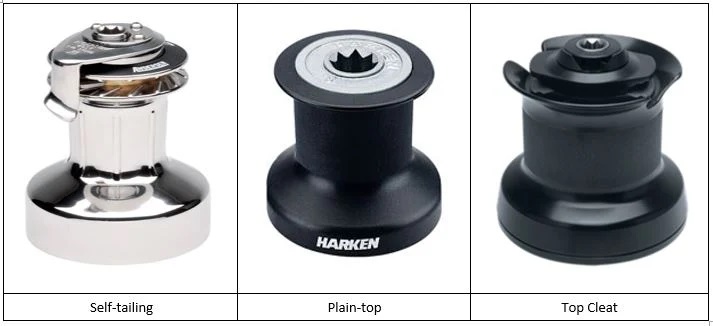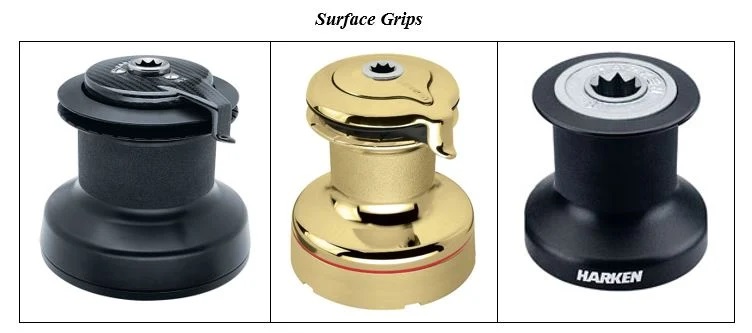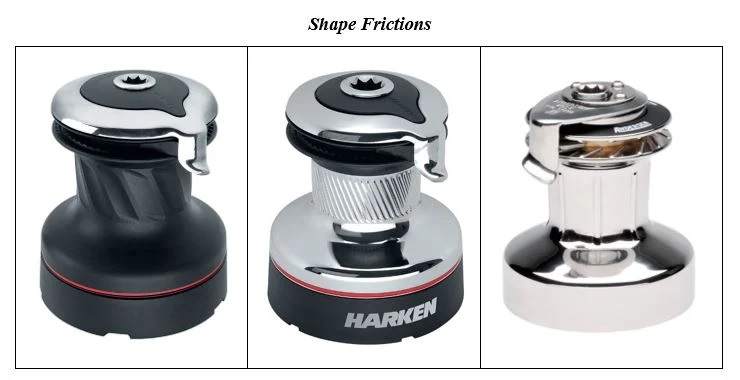Now that is a tongue twister! However, we have attempted to classify the main different types of sailing winches into a quick, and much simpler, 6 minute read and we will help you to buy right sailing winch for your boat.
Single and Multiple-Speeds of sailing winch
Single-speed winches can be geared or non-geared. They pull in the rope when turned in one direction and ratchet when turned in the opposite direction. At higher loads, a pull-push-pull action can be less tiring than complete 360˚ turns.
Multiple-speed winches have different gearing depending on the direction of rotation. The first speed may be either “direct drive” (non-geared) or geared. A combination of gears on a typical two-speed winch (e.g. Harken 40) is 2.13 & 5.65, resulting in power ratios of 13.5 & 39.9. Although this ‘multiplies’ input force by a factor of 40, it must be remembered that it also reduces the speed at which the rope comes in, by the same factor.
Three-speed winches offer a third gear by switching the direction of rotation of the handle back to that of the lowest speed, normally by engaging a button for the first gear. Progression of gears might be:
- Clockwise: 2.2
- Anti-clockwise: 4.8
- Clockwise: 14.4
Once the basic load / size of the sailing winch has been selected, the next criteria to consider is the range of loads that the rope will hold and hauling speed.
A genoa sheet that initially needs to be wound in quickly but sees high loads will benefit from a 3-speed, with a non-geared highest speed. A 3-speed is also ideal for multi-tasking across several lines.
When speed is less imperative, and maybe pulling strength a little lower (for example when cruising), a two-speed winch with higher gearing may be more appropriate.
Plain-top, Self-tailing and Top-cleating winches
Self-tailing winches free up a hand to increase power on the handle. It is imperative with self-tailing winches to check line size specifications; too small a rope and the jaw will not grip well; too large and the jaw may damage the rope.
Plain-top winches are usually seen on smaller racer boats, where lines are constantly being trimmed, or where quick release of the line is imperative.
Some larger, racing orientated winches have a Top-Cleat that rotates with the sailing winch. They are a fast, tidy way to secure lines. The absence of a self-tailing arm can make for a quicker and safer cast-off, still allowing some fine-tuning without releasing the line from the cleat. Top-cleats are typically used for primaries but don’t offer sufficient security for holding halyards.

Sailing Winch Materials
- Anodised alloy, or aluminium, is the most cost-effective material with a lightweight, relatively resistant finish
- Stainless steel offers a more durable finish but weights 30-50% more than aluminium and is more expensive. N.B. stainless steel winches can come in a range of different finishes
- Chrome gives an attractive, durable finish, but is 40-60% heavier than aluminium.
- Bronze finishes are usually only seen on traditional yachts. They enhance aesthetic but require frequent polishing
and can be over 60% heavier than aluminium.
- Carbon fibre winches are the lightest option for high-spec racing yachts, offering a weight saving of 15% over aluminium.
Grip
This will either be shape friction, where the grip comes from the shape of the drum, or surface friction, where the surface is roughened. The former is kinder to your ropes, but surface friction will be more effective on high tensile strength, small diameter racing sheets. Surface grips deteriorate over time and can be costly to re-surface.
For Harken Radial winches, the grip ridges are also shaped to drive the rope towards the bottom of the drum when easing, which helps prevent riding turns.


Conclusion on Sailing Winches
When selecting a sailing winch, you must be aware of all conditions such as sailing style, load and speed requirements, space limitations, and boat size. Manufacturer recommendations are guides but it is always advisable to receive external help from an expert when it comes to choosing a new winch.
If you have any questions about manual sailing winches, please feel free to email us at [email protected], or click the link below to see our full range:


Which Sailing Winch?